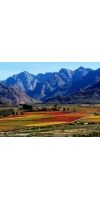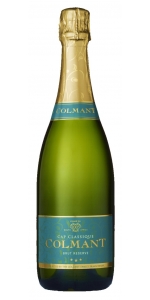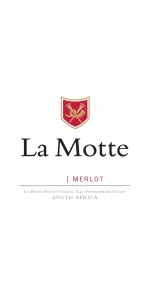Wine from Franschhoek

The Franschhoek Valley is located in the cape of South Africa. Franschhoek is a small wine region that is just east of the Stellenbosch wine region. Vineyards cover the mountainous slopes with Chardonnay, Sauvignon Blanc, Semillon, Cabernet Sauvignon, Chenin Blanc, Shiraz, Merlot, and Pinot Noir being the most popular varieties produced in the region.
The French Huegenots settled the area over 300 years ago, and brought their knowledge of viticulture to the Franschhoek region. After Protestantism was outlawed, Huguenots came to the Cape of Good Hope after fleeing France.
Thirty-seven wine growers collaborated in 1945 and formed the Franschhoek Co-Operative Cellar growing to 95 producers and peaking in 1984. Over the years, some vineyards have been replaced by citrus and fruit trees.
The warm climate is influenced by the sheltering affects of the coastal mountains, which help keep the vines cool and dormant during the cold winter. The vineyards that lie above the snow line can become frozen during the coldest months. Franschhoek enjoys heavy precipitation during the rainy season giving the region alluvial soil.
The Franschhoek Valley is a small wine industry known for estate and boutique wine farms. The growers are specialists and understand the particular needs of each wine.
Colmant Brut Chardonnay is made from 100 percent Chardonnay (Franschhoek and Robertson).
15% of the base wine has been barrel fermented.
Ageing: This wine spends a minimum of 45 months on the lees at a consistent temperature of 14C before degorgement.
Tasting: Delicate light gold color with a lime-green hue. The nose is fresh, lemony and floral with notes of green apple, followed by yeasty and biscuity aromas brought by the lengthy maturation on the lees. Very fine bead of bubbles with a persistent mousse. Opulent on the palate, this wine shows a harmonious balance between fresh zestiness, mineral complexity and a warm breadth of leesy creaminess. It promises to develop great texture over time.
Drinking tips: Ideal with pan fried scallops or line fish "au beurre blanc", it is also the oyster's best friend and will enhance the flavors of parmesan, asparagus, artichokes, parma ham,…
Reviews:
"The core of this wine, which subsequently spent 52 months on lees, comes from the 2015 vintage and shows the ageing potential for which Colmant bubblies are famous. Savoury, fresh and intense, with plenty of colour, added complexity from reserve material, notes of aniseed and citrus peel and a fine, refreshing finish. 2021-25"
- Tim Atkin (South Africa 2020 Report), 93 pts
There are many alternatives to Champagne, and South Africa is no exception with some fine “Method Cap Classique.” Jean-Philippe Colmant hired winemaker Nicolas Follet to create a small range of impressive sparkling wines; they eschew malolactic fermentation and practice extended lees aging.- NM"
- eRobertParker.com (Issue #196, August 2011), 92 pts
A blanc de blanc with the heart of Chardonnay, the NV Brut Chardonnay has focused citrus tones on the nose with notes of yellow pear and green apple. The oak is subtle here, with a solid beam of acidity through the mid-palate. The wine is thoughtful and focused, and the finish leaves my mouth watering; there is serious acidity here, and they are doing it right. Colmant is the little guy doing some really great things— quietly focused wines, with serious aging potential. Keep this small producer on your radar. I expect nothing but great things in years to come from JP Colmant and his new winemaker, Paul Gerber, formerly of Le Lude. - Anthony Mueller"
- Robert Parker's Wine Advocate (Issue #245, October 2019), 91+ pts
"Our favorite Colmant sparkler by far, this blanc de blancs would easily pass for good quality Champagne. It’s pale straw with a fine bead with biscuit and lemon aromas. Very flavorful and complex on a rich palate with a persistent finish, it’s 100% Chardonnay, 15% barrel fermented, and spends 4 years on the lees. RS 5 g/L"
- I-WineReview 92 pts
IMPORTER SALE!
Blend: Colmant Brut Reserve NV is a blend of Pinot Noir 52%, Chardonnay 48% (Franschhoek, Robertson, Elgin, Somerset-West and Stellenbosch). 10% of the blend is made of reserve wine from the previous vintage and 12% of the base wine is barrel fermented.
Ageing: 28 months minimum on the lees at steady 13°C temperature.
Tasting: A subtle pale gold color with a very clean and elegant nose. The aroma has a gentle spicy toastiness with a lemon / yeasty perfume followed by more mature fruit. Plenty of freshness on the palate, with a good acidity which perfectly balances the yeasty depth, bready flavors and ample structure. Long smooth finish. Will develop nicely over the years.
Drinking tips: Divine as an aperitif and loyal as a party buddy, it also goes perfectly with oysters, sushis or any delicate seafood.
Reviews:
"The Brut Reserve (disgorged April 2018) was 10% fermented in French oak barrel and includes 20% reserve vintages. It spent 30 months on the lees. The well-defined, focused nose features bright citrus lemon and hints of baked bread. The palate is well balanced with a taut, crisp, citric entry. This is vivacious, very pretty and graced with lovely apricot hints on the finish. A superb MCC from Colmant. - Neal Martin"
- Vinous (August 28th 2018), 91 pts
"Fresh with leesy notes, a fine mousse and delicate palate of minerals and green citrus zest, this is a first class New World sparkler. It’s rich enough to enjoy on its own or with white meats. It’s a 50/50 blend of Pinot Noir and Chardonnay aged on the lees for 30 months and 25% reserve wines from earlier vintages."
-International Wine Review, 91 pts
"Disgorged February 2011, the Non-vintage Brut Reserve is a blend of 52% Pinot Noir and 48% Chardonnay based on the 2008 vintages blended with reserve wines from 2007 and 2006 (25% of the blend), aged for 30 months on the lees. It has a very fine pettillance in the glass. The nose is very well defined with crushed stone, oyster shell and the subtle perfume of fine lees coming through with aeration. The palate is very crisp and lively on the entry with vibrant acidity, a citrus thread from start to finish, and though it is not a powerful Cap Classique, it is wonderfully poised with great persistence on the fresh lime and Granny Smith-tinged finish.
There are many alternatives to Champagne, and South Africa is no exception with some fine “Method Cap Classique.” Jean-Philippe Colmant hired winemaker Nicolas Follet to create a small range of impressive sparkling wines; they eschew malolactic fermentation and practice extended lees aging."
- eRobertParker.com , 92 pts
Our Hunt for Colmant:
It was day 6 in South Africa and we find ourselves outside of beautiful Cape Town, in the country near the Riebeek Kasteel area in Swartland. Let's talk a little about my accommodations before I tell you about this amazing bubbly. We arrive at the one and only hotel in Riebeek to find out that there were not enough rooms open for all.
We reached out to our contact at Riebeek cellars, who we will refer to as "Point Break" from now on. For those of you that have not seen the movie Point Break, this guy looked and sounded like a blonde Keanu Reeves with a Dutch accent. Anyway, Point Break tells me that they have secured a small bed and breakfast that we could use for the overflow. Sounded nice...so I opted for it.
Upon arrival, the home was beautiful on the outside with a catchy French name, "Shades of Provence". After Point Break fiddled with the skeleton key and lock for a good 35 minutes in the rain, we finally get to see the inside of our new home. The door opened straight into the kitchen where the first thing I noticed was the mouse sh*t all over the place. It was winter there and the mice were trying to stay warm, I'm sure. Little did they know this damn place had no heat.
Besides myself and my fiancee Sylvia, there were 3 other people and a total of four rooms. At this point I knew I better drag both our suitcases up those steps and get to the best room before everyone else. At stroke-causing speed, I skipped up the steps nearly knocking Point Break on his back and went through the rooms. I settled for a nice corner room with the least amount of dirt on the concrete floor and with only one or two spider webs on the wrought iron bed post.
For dinner that night, we returned to the hotel restaurant to join the rest of our group. The 5 of us forced to stay in the bed and breakfast were in a far worse mood than everyone around us. Arriving late, we sat at the end of the dinning table and hoarded as much wine as possible to try and drink ourselves to a point where we could sleep in that disgrace of a French country side home that Point Break secured for us.
That night, I slept with the lights on, all my clothes on, and on top of the sheets hoping to avoid spider bites. I awoke that morning to Sylvia standing over me holding what looked like a hot water knob off of the shower. "It wasn't even attached.", she said. Sylvia proceeds to take a "whore-bath" in the sink using her own packed sock as a wash cloth. It was the only thing she deemed clean. To top it off, in a brief moment of happiness she finds a hair dryer in a cabinet. She pulled it out in triumph only to realize that there was a used condom stuck to the side of it. Obviously, this is her last trip to South Africa.
La Motte Merlot is made from 100 percent Merlot.
La Motte Merlot offers a bouquet of red currants, cherries and spicy oakiness. It is an elegant, well-balanced and juicy wine with an underlying, refreshing quality.
Excellent with lamb, roasts or casseroles.
Review:
"Medium garnet color. Aromas and flavors of smoked meat, toast, leather, grilled plum, baked cherry tart, cracked black pepper, and myrrh with a round, lively, dry medium body and a smooth, interesting, medium-long finish with notes of chocolate-covered pecans with well-integrated, fine, firm tannins and light oak flavor. A savory and juicy Merlot with a strong sense of place; try with most meat dishes."
- Beverage Testing Institute (April 2021), 90 pts
- back
Selected Options
Regions
Categories
Pricing
Countries
Regions
Grape Types
Wineries
Organic/Free Shipping
From the most recognized Napa Valley red blend comes a distinct, new wine. Made in the same iconic style as The Prisoner Red Blend, we proudly introduce The Prisoner Cabernet Sauvignon. Redefining taste once again.
On the nose, blackberry, currant, and plum are layered with dried, crushed herbs and licorice. On the palate, cedar, vanilla, nutmeg, and toasted coconut lead as plum and dried blackberries culminate in a lush, full mouthfeel and a lengthy, balanced finish.
Chef Brett recommends pairing The Prisoner Cabernet with Grilled Ribeye or Aged Gouda Cheese.
Chateau La Nerthe Chateauneuf-du-Pape Rouge is made from Grenache 39%, Mourvédre 33%, Syrah 25%, Cinsault 2%, Others 1%.
Château La Nerthe is one of the oldest estates in Châteauneuf-du-Pape and dates from 1560. Château La Nerthe has 227 acres of vineyards that surround the château and top the renowned La Crau plateau. The terroir is typical of the region. Vineyards run along a slope and grow in sandy-clay soils. The ground is covered by a layer of ‘galets’ – large, round, well-worn stones that were carried down from the Alps by glaciers during the last ice age. All the 13 permitted primary varietals are planted here. Grenache dominates 62% of the vineyards and the average vine age is over 40 years old. The grapes are hand harvested and sorted on tables. The grapes are then put into vats for almost 4 weeks with regular pump overs and punch downs. The must is tasted every day during fermentation to ensure the best extraction of the berry compounds. At the end, the wines are racked into oak vats for malolactic fermentation. The cuvée is then aged in large French oak casks and barrels for 12 months before blending. Bottling takes place 6 months later.
The dark, deep, inky color of the wine shows immediately, stemming from the concentration of the vintage. Nose of blackcurrants, black tea and dried flowers stands out. The mouth is rich, fruity and velvety with an incredibly layered tannic structure. The wine is balanced and pure with strong intense and incredibly long aging potential.
- One of the oldest estates in Châteauneuf-du-Pape - dates from 1560
- Estate grown, hand harvested, estate bottled
- Average vine age is 40+ years
- Certified AB Organic
Review:
A focused expression, this wine delivers pure red and black fruits unfolding against a delicate rose-petal backdrop. Silky yet chewy tannins gradually reveal layers of red cherry, pomegranate, spice, violets, and a hint of clove. Its elegance is underscored by fine tannins, suggesting a wine that, while quiet now, holds the promise of revealing its full beauty with time in the bottle. Cellaring through 2028+ before revisiting should prove to be rewarding.
-Wine Enthusiast 93 Points

-150x300.jpg)





